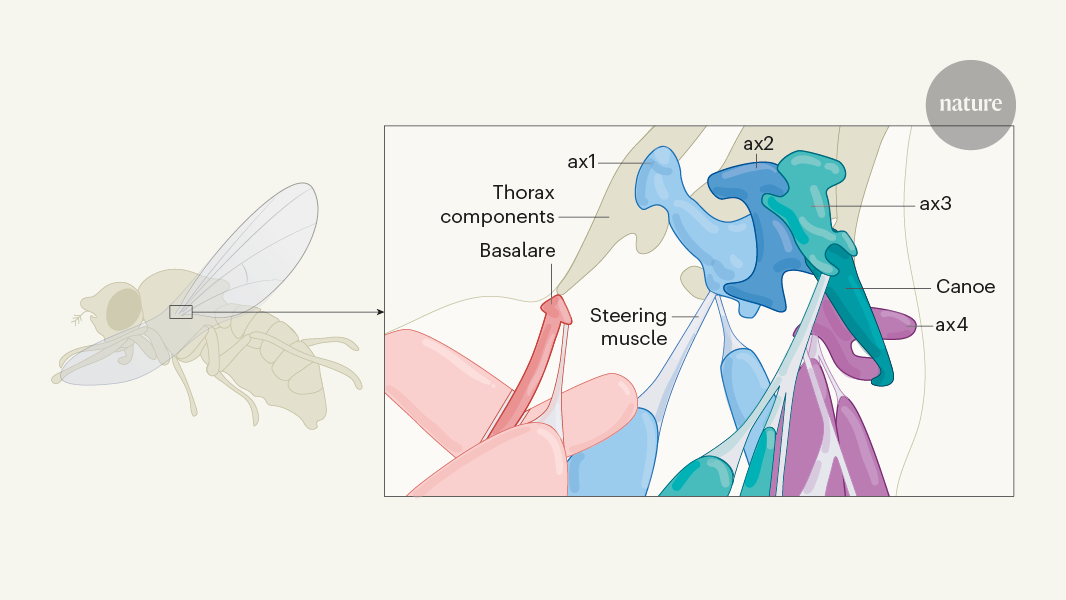Unveiling the Intricate Mechanics of the Insect Wing Hinge: A Crucial Adaptation for Flight
Core Concepts
The insect wing hinge is a critical yet poorly understood joint that enables the remarkable flight capabilities of winged insects, a highly successful group of animals.
Abstract
The content explores the functioning of the insect wing hinge, a crucial joint that connects the wing to the insect's body. Winged insects, such as butterflies, wasps, and beetles, are remarkably successful animals in terms of species diversity and population size. This success is largely attributed to their ability to fly, which is enabled by the evolution of wings as a new type of appendage.
Despite the importance of the wing hinge, its small size, fast movement, and the difficulty in directly observing it have made understanding its mechanics challenging. The article discusses how the recent study by Melis et al. has made significant progress in unraveling the riddle of how the insect wing hinge functions.
The content highlights the exquisite nature of the wing hinge and its critical role in insect flight. It suggests that the successful evolution and diversification of winged insects can be partly attributed to the adaptations and capabilities enabled by this specialized joint.
An exploration of how the insect-wing hinge functions
Stats
Winged insects are some of the most successful animals on the planet, in terms of numbers of species and individuals.
The wing hinge is an important joint, but its small size, fast movement, and the difficulty in directly observing it have made understanding how it works challenging.
Quotes
"Winged insects, including butterflies, wasps and beetles, are some of the most successful animals on the planet, in terms of numbers of species and of individuals."
"Part of this success comes from their ability to fly and from the evolution of wings, which have evolved as a new type of appendage, independently of limbs."
Key Insights Distilled From
by Tanvi Deora at www.nature.com 04-17-2024
https://www.nature.com/articles/d41586-024-00912-0
Deeper Inquiries
How do the specific mechanical properties and structural adaptations of the insect wing hinge contribute to the remarkable flight capabilities of winged insects?
The specific mechanical properties and structural adaptations of the insect wing hinge play a crucial role in the remarkable flight capabilities of winged insects. The hinge allows for the controlled movement of the wings, enabling insects to generate lift, thrust, and maneuverability during flight. The hinge's small size and fast movement are essential for the rapid wing beats required for sustained flight. Additionally, the hinge's flexibility and durability help withstand the forces exerted during flight, ensuring the wings can withstand the stresses of aerial maneuvers. Overall, the mechanical properties and structural adaptations of the insect wing hinge optimize the efficiency and effectiveness of insect flight.
What are the potential limitations or trade-offs in the design and function of the insect wing hinge that may have constrained the evolution of insect flight?
Despite its remarkable capabilities, the design and function of the insect wing hinge also come with potential limitations and trade-offs that may have constrained the evolution of insect flight. One limitation is the size and complexity of the hinge, which can limit the range of motion and flexibility of the wings. This constraint may have influenced the evolution of wing shapes and sizes in different insect species to optimize flight performance within the limitations of the hinge structure. Additionally, the trade-off between durability and weight in the hinge design may have influenced the evolution of flight strategies in insects, balancing the need for robustness with the need to minimize energy expenditure during flight.
Could the insights gained from understanding the insect wing hinge mechanics be applied to the design of bio-inspired aerial vehicles or robotic systems?
The insights gained from understanding the mechanics of the insect wing hinge hold significant potential for application in the design of bio-inspired aerial vehicles or robotic systems. By mimicking the mechanical properties and structural adaptations of the insect wing hinge, engineers can develop more efficient and maneuverable flying machines. For example, the fast movement and flexibility of the hinge could inspire the development of flapping-wing mechanisms for micro air vehicles, enhancing their agility and stability in flight. Additionally, the durability and lightweight nature of the hinge could inform the design of robotic systems that require both strength and efficiency. Overall, understanding the insect wing hinge mechanics opens up exciting possibilities for the advancement of bio-inspired aerial technologies.
0
